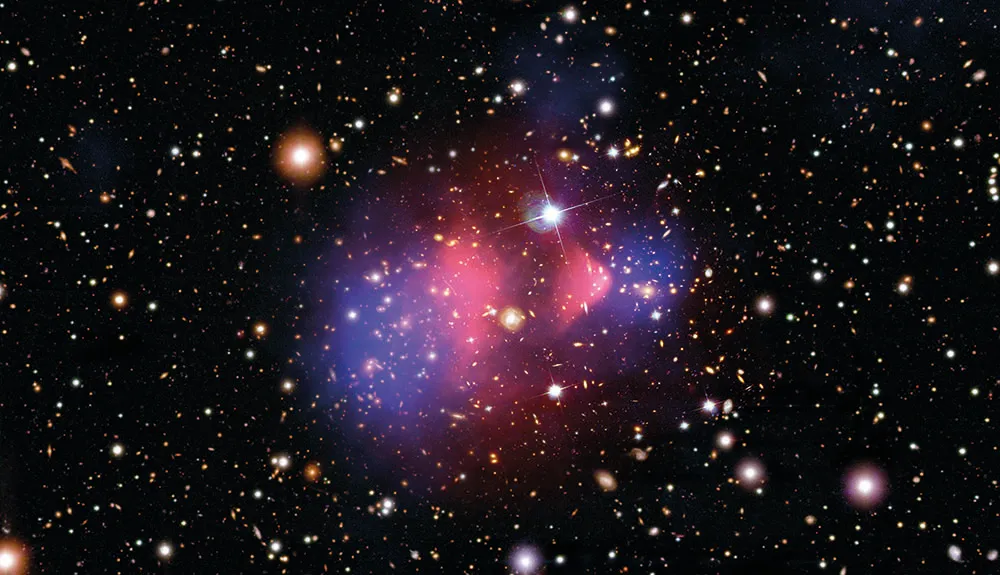Dark matter is an invisible type of matter theorised to make up the majority of all matter in the Universe. It has mass, but it can't be seen and doesn't interact with ordinary matter.
How much dark matter is there?
According to our standard model of cosmology, dark matter makes up 85 per cent of all the matter in the Universe, and 27 per cent of the Universe's total mass-energy.
Who discovered dark matter?
In 1933, Swiss astronomer Fritz Zwicky studied the motion of galaxies in the Coma Cluster, comparing the mass it contained to the speed of orbit of the individual galaxies. What he expected to find was that the amount of gravity pulling galaxies into the centres of the cluster would account for how fast they were orbiting.
Imagine a comet zipping past the Sun. How much the comet's path will bend towards the Sun depends on two things: how fast it is travelling, and the strength of the Sun's gravity. If the gravity is strong enough, the comet will be trapped in an orbit; if not, or if it is travelling too quickly, the comet will shoot off into space.
What Zwicky found was that the galaxies at the outer edges of the cluster were travelling far too quickly for the gravity to hold them in an orbit. So what could be keeping them there?
Estimating the number and brightness of the galaxies in the cluster gave Zwicky an approximation of the mass, which he used to calculate the gravity. Since his estimate was too small, he theorised that there must be mass he can't see. He called this dunkle Materie, or 'dark matter'.
This dark matter would have to have some strange properties. It has mass, so it has a gravitational force. But we can't see it, which means that it doesn't give off or reflect light.
What other evidence is there for dark matter?

Located around 3.8 billion light-years from Earth is a pair of colliding galaxy clusters. The smaller of the two, known as the Bullet Cluster, is piercing its way through the larger one.
In the image above, the galaxies that make up the clusters are shown in orange and white, and the clusters' hot gas, which emits X-rays, is shown in pink. These make up the 'normal' matter in the galaxy clusters.
The blue areas of the image, on the outer edges, are the majority of the mass in the clusters. This mass was detected thanks to an effect known as gravitational lensing.
Einstein's theory of General Relativity tells us that spacetime itself is distorted by mass, which is an effect that we see as gravity. Everything in the Universe is affected by it – even light. So, even if we can't see the matter itself, we can see the way light bends in its presence.
So, most of the matter in these colliding clusters is neither galaxies nor hot gas, but something with mass that we can't see.
The Bullet Cluster gives us insight into another aspect of dark matter. The dark matter has travelled much further following the collision than the hot gas, and is now on the outskirts if the cluster. While the hot gas felt a drag force during the collision, like air resistance, the dark matter didn't. This means that it doesn't interact with itself or with normal matter – unless by gravity.
What is dark matter made of?
Despite its name it can’t simply be made up of dead stars, gas and dust. Dark matter has to consist of something more exotic than standard atomic particles to ensure the Big Bang produces a universe chemically similar to the one we see.
Such observational constraints have forced theorists to focus on a handful of candidates for dark matter.
The main contenders include so-called weakly interacting massive particles (‘WIMPs’) and gravitinos, whose existence is predicted by theories aimed at unifying all the fundamental forces and particles of nature, and axions, predicted to exist by theories of how atomic nuclei hold together. Experiments now underway at the Large Hadron Collider could soon reveal the truth. - Alexandra Franklin-Cheung
Read more about alternative explanations for dark matter: